
Breathing life into BATIK
Sachitra MAHENDRA
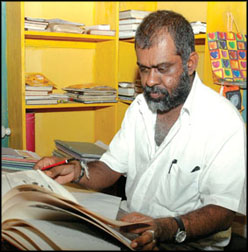 ‘Batik’, an art and craft that originated in Indonesia, has been a
household name in Sri Lankan design culture for centuries. It has
invaded the fashion scene among both foreigners and locals. You hardly
see an eve without Batik’s grace. ‘Batik’, an art and craft that originated in Indonesia, has been a
household name in Sri Lankan design culture for centuries. It has
invaded the fashion scene among both foreigners and locals. You hardly
see an eve without Batik’s grace.
For Sujeewa Jayasena, Batik was a mystery yet to be explored way back
in 1980 but today he heads his own Batik company ‘Picasso Blackline’
which rises in the early hours of the dawn lighting hearths for dyeing
mixtures of Batik.
 Sujeewa has designed 3,000 patterns, and the 3,001st, the latest
pattern, portrays the sun. His latest design, he hopes, will brighten
throughout his life. Sujeewa has designed 3,000 patterns, and the 3,001st, the latest
pattern, portrays the sun. His latest design, he hopes, will brighten
throughout his life.
Sujeewa’s first exposure to the international arena was a painting
competition held in India.
“I had no idea on what I should paint. Luckily, my teacher, Wimalsiri,
approached me and related that I should paint something rare and
distinctive.”
So to say, the Kandy Perahera concept remarkably crossed his head. He
breathed life into the concept with his inimitable black and white line
art.
A surprise was in store for him when it brought the Jawaharlal Nehru
Award, the second highest laurel in India. It was the starting point and
he had clinched 179 awards so far. His second painting portraying the
Veddah community dances earned him the Golden Award in Japan. Impressed
by his designs the award committee even granted him a scholarship.
Sujeewa’s childhood was full of financial problems, though he was
fortunate to attract many dignitaries like politicians and chief monks
with his talents.
“I remember the then President asking me how he could help me as the
first citizen. Then Prime Minister came to know about me through the
President.
He recruited me as his chief designer, and gave the opportunity to
travel all over the country to study different paint mediums. It was Ven.
Gnanissara of Gangarama temple who used to send me a pastel box every
month in my childhood.”
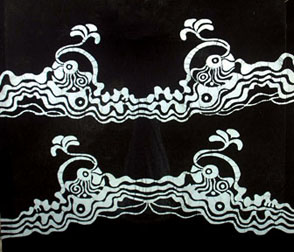 |
|
Two beings give
life to another |
Rendering unto a politician makes you out as a nerd sometimes, as you
‘ask for troubles’. Sujeewa’s was no exception, as he had already earned
enemies from many fronts just for being the ‘premier’s artist’.
“The late 80s was a politically risky period. I had to drop my plans
of going to the Institute of Aesthetic Studies because of mounting
threats. Luckily the Prime Minister got down a lecturer from the
institute and gave me the home-university privilege. I learnt everything
a university student learns within two years. Later he sent me to Japan
to follow a course on water colour for six months.”
Life was distasteful for Sujeewa with all threats against him. His
sincere longing was to remain in Japan, but the Premier wanted Sujeewa.
Sujeewa had been with the President as his chief artiste for six years,
when thoughts of retirement slowly slipped into his head.
“Many official high ups were exploiting the President’s position.
They all won high positions undeservedly. I started having frustrated
feelings on the country’s administration, though I had no personal issue
with the President.
He was a gentleman, though many of his officials were not. They were
scared that I would get a high position. I finally made a decision to
take my leave.” Sujeewa settled in Nugegoda. He was unemployed for some
time, until he was introduced to Buddhi Keerthisena by Kusal Jayawardene.
“A Former Minister was his chief designer but he was already making
plans to go abroad. So Keerthisena wanted me to fill that vacancy. He
exposed all the secrets in the Batik industry.”
Sujeewa got a rare chance of studying painting on glass under a Swiss
teacher within this period. Having served Keerthisena for a number of
years, Sujeewa was entertaining the thought of starting a Batik company
of his own.
“Keerthisena’s opinion was that I am the best person to succeed his
Batik industry. I gave his advice a thought, and started a Batik
industry on my own in a small scale.”
In the meantime, he wanted to have his Batik garments sold at ‘House
of Fashion’. He was determined to meet Preethi and Neelamani Jayawardana,
directors of the company.
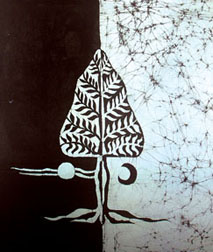 |
|
One of Sujeewa’s patterns
portraying the light of life |
“I missed them seven times. When I finally met them they asked me to
supply 10 pieces. I sent them the following day, and they were
surprisingly sold even before dusk settled. Demands came in and I had to
increase my output. I am invited for contracts with other apparel
companies today but I stick to ‘House of Fashion’as I consider them to
be my second parents.”
Sujeewa’s next cornerstone is the appointment as chief designer in
two major poster designing companies in America. He was handpicked out
of six foreign representatives.
“I emailed my certificates and creations. I get my contracts over the
Internet,” he said.
Sujeewa travels around the world and the country in his free time.
The ancient painting styles influence his creations.
“Theory is not enough. You should study them practically. For
instance, you should observe Egyptian paintings closely. You should
study ancient temple paintings.”
With all the riches coming his way Sujeewa has not forgotten his
roots.
“I had financial problems when I started life. Thankfully I do not
face any today. I like to give a helping hand to a student who has a
flair for the art. If there is a student at University of Visual and
Performing Arts who faces financial issues, I like to help them. It’s
just a matter of contacting me on 0724104259.”
Japanese style ‘Expressions’
  Nihonga or literally “Japanese-style paintings” is a term used to
describe paintings that have been made in accordance with Japanese
traditional artistic conventions, techniques and materials. Based on
traditions of over a thousand years, the term was coined in the Meiji
period (1868-1912), to distinguish such works from Western-style
paintings. Nihonga or literally “Japanese-style paintings” is a term used to
describe paintings that have been made in accordance with Japanese
traditional artistic conventions, techniques and materials. Based on
traditions of over a thousand years, the term was coined in the Meiji
period (1868-1912), to distinguish such works from Western-style
paintings.
Ffascinated by the simplicity of Nihonga, artist Pradeep Ruwanpura
and was able to experience the magic of the art during his stay in Japan
from 2000 to 2005 whilst reading for his PhD in Biochemistry at the
Tokyo Medical Dental University.
During this time he met Inoue Seisui, an eminent artist and a teacher
of Nihonga whose teacher too was well recognised as a painter at the
imperial palace. Seisui became Ruwanpura’s teacher, mentor and guide and
encouraged him to make his dream of painting Nihonga a reality.
Nihonga is typically executed on washi (Japanese rice paper) or on
silk, using brushes. The paintings can be either monochrome or
polychrome. If monochrome, typically Sumi (Chinese ink) made from soot
mixed with animal glue is used - hence the term Sumi-e (e, pronounced
ye, meaning painting).
If polychrome, the pigments are derived from natural ingredients:
minerals, shells, corals, and even semi-precious stones like garnets or
pearls. Animal glue is used as fixative for these powdered pigments.
In both cases, water is used; hence Sumi-e is by definition a
sub-genre of watercolor painting. Initially, Sumi-e were produced for
hanging scrolls, hand scrolls or folding screens. However, most are now
made to be displayed in frames, similar to Western-style paintings.
By studying Sumi-e, Ruwanpura was not only learning the brush strokes
and principals of the art itself, but also experiencing the Japanese way
of seeing nature and understanding life.
He learnt to express his feelings through Sumi-e which is more of an
exercise of meditation and discipline rather than a mere method of
painting.
‘Expressions’, an exhibition of Japanese Style Paintings by Ruwanpura
will be held at the Alliance française de Kandy from September 6 to 12.
The opening ceremony will be held on September 5 at 6 pm and will be
decleared open by Governor Central Province, Tikiri Kobbekaduwa.
Exploring the depths of fantasy
J.R.R. Tolkien’s 35th death anniversary today:
 |
|
J.R.R. Tolkien
|
“This tale grew in the telling, until it became a history of the
Great War of the Ring and included many glimpses of the yet more ancient
history that preceded it.
It was begun soon after The Hobbit was written and before its
publication in 1937; but I did not go on with this sequel, for I wished
first to complete and set in order the mythology and legends of the
Elder Days, which had then been takingshare for some years.
I desired to do this for my own satisfaction, and I had little hope
that other people would be interested in this work, especially since it
was primarily linguistic in inspiration andwas begun in order to provide
the necessary background of ‘history’ for Elvish tongues.”
So begins the forward of one of the most read and re-read fantasy
novels of our time, J.R.R. Tolkien’s ‘The Lord of the Rings’ trilogy.
The work is based on a tale which traces the path of a powerfully
insidious ring in its new interior, a hobbit named Frodo.
Tolkien might not have contemplated the fact that he was making way
for a hunt for fantasy novels like C.S. Lewis’ ‘Chronicles of Narnia’,
Christopher Paolini’s ‘Inheritance’ and J.K. Rowling’s ‘Harry Potter’
series and many others. (It is interesting to note that C. S. Lewis,
whom Tolkien first met at Oxford, was perhaps his closest friend and
colleague, although their relationship cooled later in their lives.)
Similarly award winning filmmaker, Peter Jackson, also set a landmark
in cinema when he took up the assignment of setting Tolkien’s trilogy to
film. The movie was an instant hit and ran into packed houses in
theatres around the world.
 |
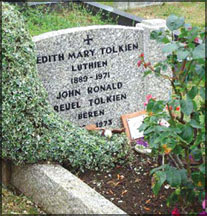 |
 |
|
The former
home of J.R.R. Tolkien in North Oxford |
The grave of
J. R. R. and Edith Tolkien, Wolvercote Cemetery, Oxford |
‘The Lord of
the Rings’ |
Yet again the sequels set a trend for a range of movies based on the
imaginary world and it is truly amazing to note that some of the
best-selling novels in the world and the movies which turned out to be
massive crowd-pullers were tales centered on imaginative creatures and
expeditions.
John Ronald Reuel Tolkien, born on January 3, 1892, introduced a
pre-historic era in an invented version of the world which he called by
the Middle English name of Middle-earth. This world consisted of humans,
Elves, Dwarves, Trolls, Orcs (or Goblins) and Hobbits.
His childhood days were no bed of roses as the family merged into the
depths of poverty after his father’s death but even at a young age the
lad showed signs of remarkable linguistic gifts.
He had mastered the Latin and Greek which was the staple fare of an
arts education and was becoming more than competent in a number of other
languages, both modern and ancient, notably Gothic, and later Finnish.
He was already busy making up his own languages, purely for fun.
Throughout his life, Tolkien had cultivated a love of language,
especially ancient languages. At Oxford he would major in philology,
which is the study of words and language.
He would be much influenced by Icelandic, Norse and Gothic mythology.
Even some of the characters and place names he would later develop would
be drawn from the names from ancient sagas.
The forest of Mirkwood, which played a prominent roll in both ‘The
Hobbit’ and in ‘The Lord of the Rings’, was borrowed from Icelandic
mythology. The names of many of the dwarves in ‘The Hobbit’ were actual
place names in the myths.
Throughout his schooldays he had been a determined poet and scholar.
His interest in language was such that he had even developed his own
languages based loosely on Finnish and Welsh. It was while recuperating
in Birmingham, with his wife at his side that he began to create a
mythology behind his languages.
This work would one day result in his famous books. Tolkein served
and survived World War I, a horrifying experience for which he lost most
of his friends.
Qualified with a first-class degree in English Language and
Literature, he was offered a professorship at the University of Leeds.
Besides lecturing, he continued work on his mythology. He felt that he,
in a sense, was creating England’s mythology.
In 1925 Tolkien with a colleague published a translation and analysis
of ‘Sir Gawain and the Green Knight’ which won him recognition. ‘The
Hobbit’, the work that would make him famous, came out in 1936, and
became a best-seller winning him instant fame.
In the late 1930’s Tolkien began writing the ‘Lord of the Rings’.
Work on the story went on for ten and a half years and the work became a
huge publishing success. He also wrote ‘The Silmarillion’, ‘The Children
of Hurin’, ‘Unfinished Tales’ and ‘History of Middle-earth’.
Fame and fortune were both a blessing and a bane for Tolkien. He
enjoyed the popularity of his work. Yet, he was burdened with work
responding to his adoring public. After his retirement at Oxford, he and
his wife Edith moved to Bournemouth in 1966. Edith died in 1971.
The loss of his life’s companion did not sit well with Tolkien; yet
he struggled on for some two years till his death of Pneumonia on
September 2, 1973.
Renowned as the creator of Middle-earth, Tolkien was one of the
greatest writers and scholars of the twentieth century.
Generations of readers have been and will continue to be enthralled
by his creations which boast of the imaginative nature of the human
mind. –RJ
Making dreams a reality
Ruwini Jayawardana

 |
|
Chairman
Laksiri Wickramage |
As their much talked about ‘Derana Dream Star’, reality TV show
approaches its climax and the channel’s successive third year comes to
completion, it’s celebrations all round for Derana. Dubbed ‘the fastest
growing channel’ according to Lanka Market Research Bureau (LMRB)
reports, Derana has much in store for their viewers in the upcoming
months, but as Chairman Laksiri Wickramage relates to the Daily News,
the channel hopes to keep mum about the projects so that viewers will be
in for a surprise as October 11 and the finals of ‘Derana Dream Star’
draws near.
Incepted in October 11, 2005, Derana airs a host of popular
programmes. Though teledramas like Sara and Doo Kumariya along with the
kids’ reality show ‘Little Star’ (originally telecast as ‘Derana Star in
a Minute’) have captured interest, it is ‘Derana Dream Star’, telecast
every Saturday and Sunday at 8.30 pm, which had taken on the masses.
Speaking on this aspect, Wickramage stressed that the programme is
not a copy of another reality television show. “There are different
genres of television programmes around the globe.
Reality TV shows are one of the emerging trends in the industry. As a
channel we needed to employ all types of genres to cater to our
audience. We started off with musical programmes targeted at certain
groups before widening our sphere to launch talent search programmes
like ‘Derana Star in a Minute’ for kids and ‘Derana Real Leader’ for
youths.
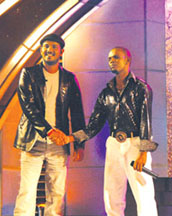 |
|
Best wishes from compere Amila
|
‘Derana Dream Star’ was an oblivious choice because it employed one
of the most popular genres of reality television. It is true that it had
been tried out in Sri Lanka before we came to the scene but we aimed at
launching the programme in an international scale.
This means ‘Derana Dream Star’ involves the latest equipment and
techniques to bring a quality reality TV programme from the country’s
biggest television channel studio,” he said also adding that the
contestants are graded for their singing as well as for their
performance on stage.
The youths are able to showcase their versatility through dance and
by playing musical instruments. Contestants who take part range from 16
to 25 years.
“We studied different genres of reality programmes around the world
and noted some of the most popular elements in them. ‘Derana Dream Star’
was designed by combining some of these elements,” he explained.
Another aspect in store are some reality television techniques that
no other channel in Sri Lanka had ever experimented with before but
Wickramage prefers to keep the viewers in the dark on what to expect.
“It is a matter of suspense. We do not wish to leak out what is going
to happen towards the end.
It will be a complete new experience for the fans once the
contestants are down to 12,” he said.
‘Derana Dream Star’, launched in February with around 22,000
applicants, is now approaching its finals stages. The grand finale will
take place at the Sugathadasa Stadium towards the beginning of next
year. The winner will receive Rs. two million rupees and a Suzuki Swift
car worth nearly Rs. three million.
He or she will also get a chance to record an album while the other
finalists will get an opportunity to launch a group album.
 |
|
A contestant
displays his skills on set |
“We had a pre-round at the beginning with eight panels of judges
choosing the best singers as well as the most interesting characters to
compete in the competition.
“That was done off air. After qualifying to take part in the
competition, the contestants competed with each other in the coming
weeks. Each round was different from the other and at one stage they had
to sing to unplugged music which was another unique aspect of the
programme,” Wickramage said.
 |
|
Some
contestants of ‘Derana Dream Star’ |
The competition takes place in Derana’s studio in Narahenpita. Athula
Adhikari is the music director while his band AO2 provides the music.
The team had imported a special violin from England for the event.
The jury is made up of Nirosha Virajini, Keerthi Pasquel and Rohana
Bogoda along with a guest judge who is brought in to make comments every
week. The contestants are chosen through SMS votes and a ‘Wildcard’
round is rumoured be on the way though nothing is finalised yet.
The sets are designed by Chandika Weragama while popular young
artiste, Amila Abeysekara, comperes the programme. “We are not aiming at
choosing the best singer. The judges have chosen 48 immensely talented
youths and the public will be choosing the star among them.
“A person can emerge as a talented singer but it takes more than
talent alone to become a star. You need to possess a certain charisma to
mesmerise your audience,” Wickramage pointed out.
**************
Derana goes global
Derana recently launched its website www.derana.lk. According to
Wickramage the international audience can view ‘Derana Dream Star’
throught their website and send SMS votes through a special
international phone line which links them with the channel.
Plans are still underway in developing the project and Derana hopes
to keep their audience posted on the topic.
**********
Tharindu: The leader
 |
|
Tharindu |
Derana Real Leader”, Season One, concluded recently at the BMICH with
22 year-old Tharindu Prabath emerging as the winner.
He is a product of D.S. Senanayake College, Colombo, and is currently
occupied as a business executive at a private firm. Nissanka Bandara
clinched second place while Tanya Thamashni and Harshana Madhushanka
both tied for third place.
Tharindu received a Mazda cab worth Rs. 2.8 million, Rs. one million
rupees and an opportunity to pursue higher education abroad along with a
post as an executive at a leading firm. Plans for ‘Derana Real Leader’
season two is also in the cards.
Nihanda Novu Sakshi to be launched
Dr. Sarathchandra Kodikara’s latest book Nihanda Novu Sakshi will be
launched at Dayawansa Jayakody Book Exhibition Hall, Colombo 10, on
September 2 at 10 a.m.
The author is the lecturer in Medical Jurisprudence at the University
of Peradeniya.
He is also the Acting Judicial Medical Officer at the Peradeniya
Teaching Hospital. Nihanda Novu Sakshi is a Dayawansa Jayakody Book
Publication.
‘No Return’ at Tower Hall
Award winning contemporary playwright and director Rajitha
Dissanayake’s most recent theatre endeavour Aapasu Harenna Bae (No
Return) will be staged at the Tower Hall Theatre on September 5 at 3.30
p.m. and 6.30 p.m. |

